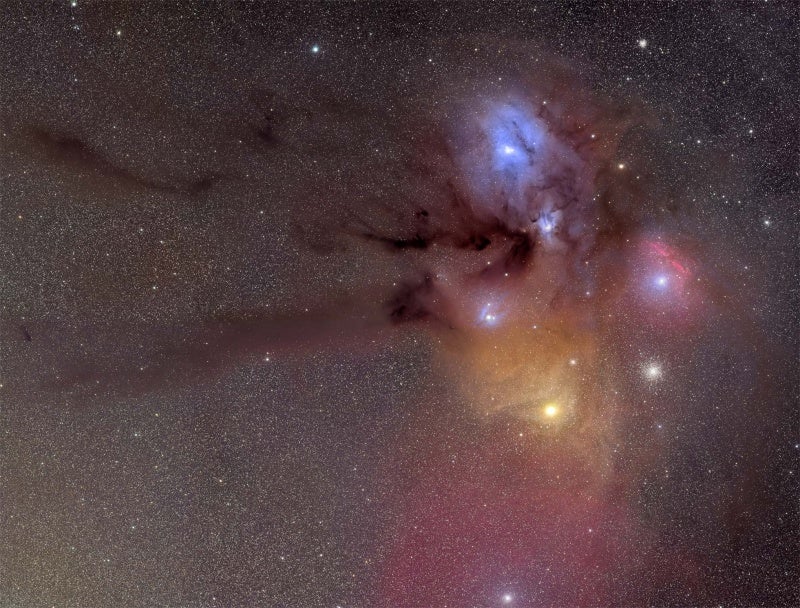Blinking red light means: Stop and look aloft
ListenMars and its red twin Antares cozy up to each other in the night sky. A small nearby galaxy intrigues astronomers focusing on the massive black hole at its core.
October 13, 2014
[Dave Heller] The same force causing a ball to bounce acts on much larger entities in much the same way. Joining me to add gravity to the situation is Derrick Pitts, chief astronomer of the Franklin Institute. Derrick, let’s get out of this world into a different one.
[Derrick Pitts] Although I can’t add anywhere near as much gravity as we’re talking about in this particular instance. We all know how gravity effects our everyday life — it causes balls to bounce, it’s what makes us tired at the end of the day if we’ve been walking around a lot and we want to sit down. It’s the gravitational pull of this planet’s mass on us that makes our muscles tired and does all these other cool things. Well it’s that same force — that very same force — that governs so much of all kinds of other things that happen in the universe, including a very interesting phenomenon that’s going on with what’s known as an ultra compact dwarf galaxy. That ultra compact dwarf galaxy has at its core a supermassive black hole. But the catch is this black hole is way out of proportion to the size of the galaxy. For example, the galaxy itself is about 300 lightyears in diameter. But the supermassive black hole is ten times more massive than the supermassive black hole at the core of our galaxy. And our galaxy is 100,000 lightyears in diameter. So why would that be?, astronomers wonder. And as it turns out, they think they have an answer. And the answer is it seems that in the history of this galaxy, another object — probably another galaxy — passing by or having some sort of interaction with its mass, its gravity stripped away all of the extra mass of the now ultra compact galaxy, allowing the supermassive black hole of such enormous size to remain with this much smaller galaxy mass.
Much like a bull in a China shop. What effect is it having on the constituents of that galaxy?
Well, that’s a really great question. The supermassive black hole that sits at the core of course is gobbling down stuff that’s nearby that keeps its energies going and keeps its activities going. And it’s also providing shockwaves that might be able to collapse whatever other hydrogen material there is, or protostellar material there is, and create new stars. And in fact, astronomers aren’t really sure yet what’s going to happen with this galaxy because this is the first of its type discovered. So now astronomers are going to look at other ultra compact dwarf galaxies to see if they also have supermassive black holes as massive as this. It might be a way to fully explain, ultimately, how these super collapsed galaxies that have such high mass, given the supermassive black holes at their cores.
-

Connecting the Pipe Nebula to the colorful region near bright star Antares is a dark cloud dubbed the Dark River, flowing from the picture’s left edge. Murky looking, the Dark River’s appearance is caused by dust obscuring background starlight, although the dark nebula contains mostly hydrogen and molecular gas. Surrounded by dust, Antares, a red supergiant star, creates an unusual bright yellowish reflection nebula. Above it, bright blue double star Rho Ophiuchi is embedded in one of the more typical bluish reflection nebulae, while red emission nebulae are also scattered around the region. Globular star cluster M4 is just seen above and right of Antares, though it lies far behind the colorful clouds, at a distance of some 7,000 light-years. The Dark River itself is about 500 light years away. The colorful skyscape is a mosaic of telescopic images spanning nearly 10 degrees (20 Full Moons) across the sky in the constellation Scorpius. (Jason Jennings/NASA)
Let’s come back a little closer to home. I understand Mars is cozying up to its evil twin.
One of the great observations of the evening sky this fall is two red objects in the same section of the sky. So in the evening after sunset, one of the planets that’s visible in the southwestern sky is Mars. And we often identify Mars as using its lovely red color. But there’s a red star not so far away that might cause confusion. And so one way you can discern the difference between the two is that the star — even though it’s red — will twinkle and the planet — also red — won’t twinkle. But ancient observers a long time ago recognized that some might be confused by this so they gave them distinctive names. So we have the Roman name for the red planet, Mars, the god of war, but we also have the Greek name being used for the red star that’s adjacent to it. And that red star’s name is Antares. Now if you break it down into its word components, you have the prefix ant-, referring to anti- and you have the suffix -ares, meaning Mars in Greek. So Antares actually means “Anti-Mars”, or not Mars. So the two together in the evening sky you have Mars, the red planet, and Antares, the red star.
Blinking red light, red light — what else is available in the night sky this week?
Actually coming up this Saturday morning very early before sunrise, say about 6 a.m., we’ll be able to see a beautiful waning crescent moon and the planet Jupiter in the morning sky together. It should look beautiful. If you’re up really early, you can see them rise at 2 a.m., and it should be visible as the sky brightens with sunlight.
WHYY is your source for fact-based, in-depth journalism and information. As a nonprofit organization, we rely on financial support from readers like you. Please give today.




